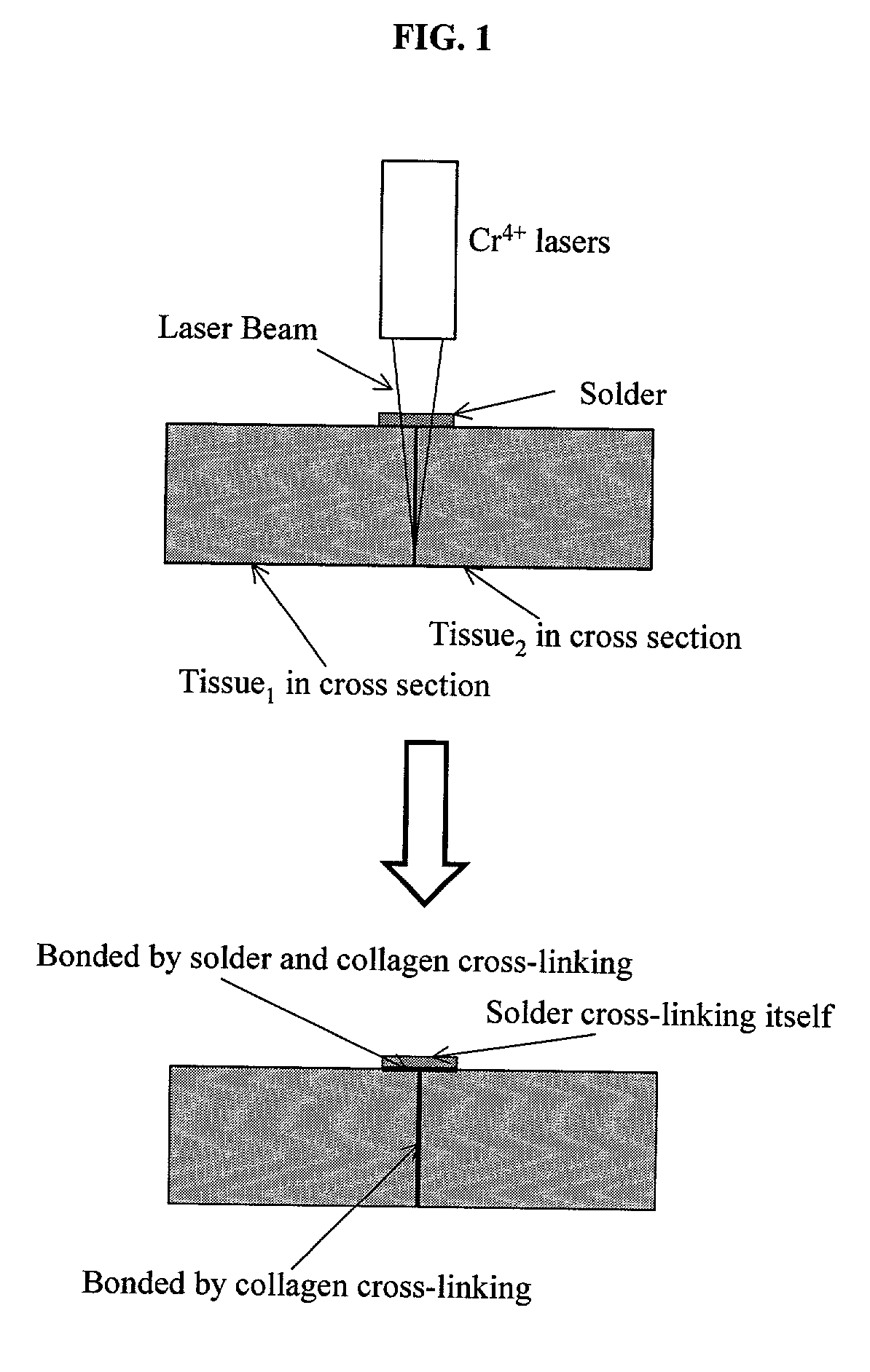Gelatin based on Power-gel(TM) as solders for Cr4+laser tissue welding and sealing of lung air leak and fistulas in organs
a technology of power gel and solder, applied in the field of gelatin, can solve the problems of inability to re-exposed to laser energy, inability to re-exposed tissues to laser energy, and scars in human applications, so as to enhance tissue weld strength and post-procedure effectiveness. , the effect of improving the strength of tissue welds
- Summary
- Abstract
- Description
- Claims
- Application Information
AI Technical Summary
Benefits of technology
Problems solved by technology
Method used
Image
Examples
example 1
[0062]Preparation of the solders: gelatin, Power-gel™, and albumin.
[0063]1. 33% gelatin. Gelatin powder from bovine skin with 225 bloom was added with 1× phosphate-buffered saline (PBS, pH 7.4). It was heated at 50° C. to become a liquid before use.
[0064]2. Power-gel™. Power-gel™ was formed by introducing mynistic acid into gelatin powder. The gelatin was combined chemically with myristic acid (CHCOOH), using an active ester method. One wt % (w / w) of aqueous solution of myristic acid was prepared at 60° C. using double distilled water under gentle stirring for 30 min. Then gelatin powder was added in the solution slowly. Myristoylation was performed in a water bath and under gentle stirring for one hour. The chemical action was performed in aqueous media at a low temperature to avoid side reaction and degradation of gelatin, but higher than the melting point of myristic acid (55° C.). The formula for Power-gel™ is shown in FIG. 2. Different concentrations of myristic acid were added...
example 2
[0066]A paperboard with a thickness of 0.1 mm was used as a support for the solder strength test. Solders prepared in accordance with Example 1 were mounted horizontally between two supports with a thickness of 0.15±0.05 mm. The paperboard with solder was then put into an oven with supports for heating at 80° C. for 2 min as an imitation of laser heating. The tensile strength of the solders were tested with a digital force gauge. The apparatus by which the tensile strength was tested is set forth in FIG. 3. The digital force gauge was connected to one support, while the other was fixed (see FIG. 3). The tension force parallel to the solder was applied until the solder broke. The maximum force was recorded automatically. The length and width in the surface of the broken solder was measured with a digital micrometer. The broken surface was calculated as length multiplied by width.
[0067]The torque strength of the solders prepared in accordance with Example 1 were tested by the apparatu...
example 3
[0073]The gelatin and Power-gel™ were mounted on microscope slides with a thickness of 0.25±0.10 mm and a surface of approximately 15×25 mm. After heating at 80° C. for 2 min, the solder on the slide was weighed and immersed in PBS at 25° C. for 24 hrs. The solder and slide were re-weighed after removal from PBS. Water uptake ability was calculated according to the following equation:
Water content (%)=[(Ww−Wd) / Ww]×100,
Where Wd is the weight of the dry solder and Ww is the weight of the wet solder.
[0074]Differences in the tensile and torque strengths (n=20 for each group) were compared by an analysis of one side variance (ANOVA) and a Student's t test. A p-value of <0.05 was assumed to represent a significant difference.
[0075]The average Water uptake ability measurement is 96.1±0.8% for gelatin and 94.6±0.1% for Power-gel™ (n=12 for each group). This shows an increased water uptake of up to 27 times for gelatin and 18 times for Power-gel™. There is a statistical significance between ...
PUM
 Login to View More
Login to View More Abstract
Description
Claims
Application Information
 Login to View More
Login to View More - R&D
- Intellectual Property
- Life Sciences
- Materials
- Tech Scout
- Unparalleled Data Quality
- Higher Quality Content
- 60% Fewer Hallucinations
Browse by: Latest US Patents, China's latest patents, Technical Efficacy Thesaurus, Application Domain, Technology Topic, Popular Technical Reports.
© 2025 PatSnap. All rights reserved.Legal|Privacy policy|Modern Slavery Act Transparency Statement|Sitemap|About US| Contact US: help@patsnap.com



